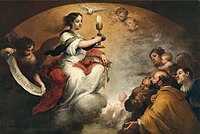| Part of a series on |
| Catholic Counter-Reformation |
|---|
 Faith, or The Church Triumphant (1665), by Bartolomé Esteban Murillo Faith, or The Church Triumphant (1665), by Bartolomé Esteban Murillo |
| Catholic Reformation and Revival |
|
Councils and documentsCouncil of Trent Exsurge Domine Decet Romanum Pontificem Confutatio Augustana Regimini militantis Ecclesiae Roman Catechism Nova ordinantia eclessiastica Defensio Tridentinæ fidei Regnans in Excelsis Ascendente Domino Immensa aeterni Dei Unigenitus |
|
PoliticsDiet of Worms Catholic League Augsburg Interim European Wars of Religion Dalecarlian Rebellions |
| Spirituality |
|
Art Schools Artists
|
|
People People Clergy
Monarchs
Popes |
| Inquisition |
| Philosophy and education |
| Religious orders |
| Related topics |
The Spanish mystics are major figures in the Catholic Reformation who lived primarily in the 16th- and 17th-centuries. The goal of this movement was to reform the Church structurally and to renew it spiritually. The Spanish mystics attempted to express in words their experience of a mystical communion with Christ.
Language and writing style
These writers had a strong influence on the development of the Spanish Language and were said to have ushered in the "Golden Age of Spanish Literature." At the beginning of the time period, the language was viewed as coarse; by the end, the language had achieved what is called "the high baroque style of Spanish," which in certain forms (especially in formal letter-writing) continues to influence Spanish usage to the present.
In addition to being examples of Christian holiness and major Spanish literary figures, the Spanish Mystics were also real reformers in the Church. Their writings inspired a religious quest for God based on desire rather than obligation and medieval legalism, and three of them went on to found or reform religious orders that would carry on their work across continents and centuries.
Principal figures and their major writings
- Teresa de Cartagena (writer)
- Grove of the Infirm
- Wonder at the Works of God
- St. Teresa of Ávila, OCD
- St. John of the Cross, OCD (poet)
- St. Ignatius of Loyola, SJ
- The Spiritual Exercises
- Autobiography
- St. Francis de Borja, SJ
- Luis de León, OESA (poet)
- Venerable Mary of Jesus of Ágreda, OIC (writer)
- Fernando de Herrera (poet)
- Blessed Ramon Lull, TOSF (philosopher of the 14th century)
Other Spanish mystics
References
- Spanish literature mystical writings, Encyclopædia Britannica, retrieved April 21, 2008
